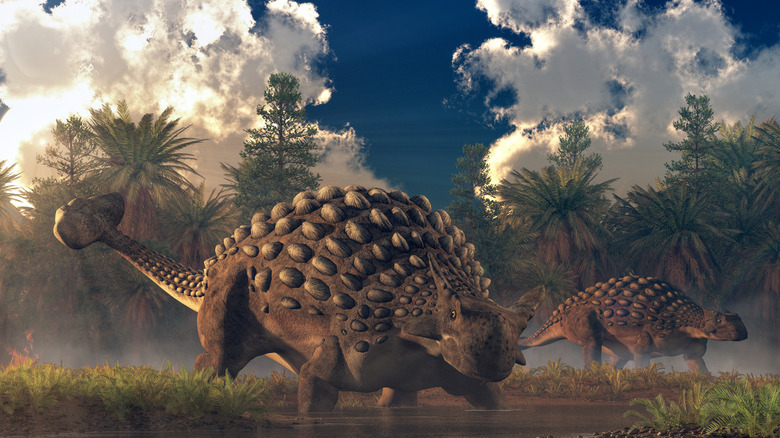Dinosaurs Once Roamed Antarctica, But The Continent Looked Completely Different
Today, Antarctica is the part of Earth with the coldest climate — a frigid landscape that also happens to be the driest and windiest environment on the planet. But millions of years ago, the continent actually played host to all manner of creatures, including dinosaurs which roamed a lush landscape unrecognizable from the ice-laden Antarctic vistas of today.
One of two continents located entirely in the Southern hemisphere, Antarctica is essentially one gargantuan sheet of ice in the Southern Ocean. In fact, it's the largest mass of ice on our planet, measuring around 7,000 feet in thickness and covering an area roughly twice the size of Australia. All of which might make Antarctica seem as though it's a barren ice-scape where nothing much happens. That's somewhat true, although the continent does perform some important roles, from helping control sea levels to reflecting heat from the sun, and even providing a home for microscopic plants which actually absorb considerable amounts of carbon throughout each year. What's more, in 2025, scientists discovered what's really hidden under Antarctica's ice, revealing a vast array of hidden submarine canyons that tell us much more about how climate change might play out in the near future. But there's no doubt the Antarctica of today is nowhere near as biodiverse as its former self: The forested continent of between 145 to 66 million years ago.
What was Antarctica like during the cretaceous period?
Antarctica as we know it began to form between 34 and 35 million years ago. Global temperatures dropped during that time, and Antarctica began enduring multiple storms which built up layer after layer of snow. These layers eventually hardened into the massive glacier we know today as the Antarctic ice sheet. Today, only the hardiest creatures can survive in such harsh environs, with Antarctica and its surrounding waters providing a home to 235 animal species, including penguins, whales, and seals.
But prior to this transformation, Antarctica looked a lot different and was populated by even more (and very different) species. For one thing, it was an entirely different landmass, beginning as part of the supercontinent known as Gondwana. By the Cretaceous period, sea levels were roughly 650 feet higher than they are today, and the area was covered in a thick, lush rainforest which gave the area significant biodiversity. Marine reptiles, invertebrates, and dinosaurs all roamed the oasis that was Antarctica, with multiple fossils providing an insight into the ancient wildlife that called the Cretaceous landscape home.
In 1986, scientists discovered the first dinosaur fossil in Antarctica, unearthing an ankylosaur specimen that lived between 83 to 72 million years ago. But as more discoveries were made, it became clear that Antarctica actually hosted a wide array of dinosaurs during the Cretaceous period. As detailed in a study published in The Science of Nature, scientists discovered the first sauropod dino remains in Antarctica in 2012 — a lithostrotian titanosaur. 2019 saw the discovery of an Imperobator fossil, as recounted in a study published in the journal Cretaceous Research, detailing the discovery of the non-avian theropod on modern-day James Ross Island, Antarctica. Research trips have also uncovered ornithopods and duck-billed dinosaurs, all of which once thrived in the lush environs of a tropical Antarctica.
How do scientists know about Antarctica's past?
Tree and animal fossils have helped scientists establish a timeline of Antarctica's land and climate history. But experts can also use the shells of small fossilized organisms known as foraminifera to help bolster their understanding of Antarctica's former climate. Foraminifera were single-celled, organisms which had shells, but not tissues or organs. Studying the shells allows scientists to determine estimates of ocean water temperature at different times throughout history.
When Dr. Brian Huber of the Smithsonian Museum of Natural History investigated the foraminifera of the Antarctic region, he and his team were surprised by what they found. As detailed in a 2018 study published in Global and Planetary Change, specimens from close to the Antarctic Circle revealed high temperatures of 86 degrees Fahrenheit (30 degrees Celsius) at 58 degrees south. Experts already knew about the Cretaceous Hothouse, which refers to a period of time in the middle of the Cretaceous when higher levels of carbon dioxide in the atmosphere made for a much warmer climate. But Huber and his cohorts' study of foraminiferal specimens strengthened the argument that the Cretaceous Hothouse was considerably warmer than similar warm periods during the last 66 million years.
As Huber told the BBC, the mid-Cretaceous period also had much faster rates of sea floor spreading, which meant there were more volcanic sources of CO2. This meant Antarctica itself was completely different from the giant ice sheet we know today — though it might soon start to look more like it did back in the Cretaceous. According to NASA, Antarctic ice has been disappearing at an average rate of about 135 billion metric tons per year since 2002. Unlike in the past, however, this rapid warming of Antarctica is worrying due to the sheer amount of CO2 being pumped into the atmosphere in the modern world, potentially meaning Antarctica will continue to lose ice.


